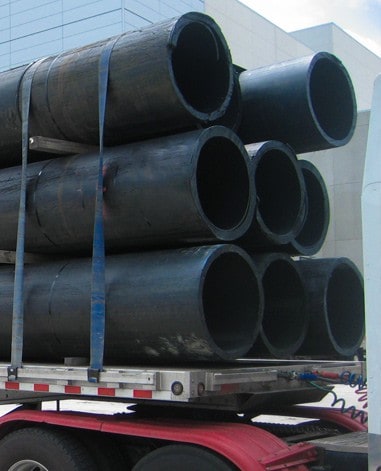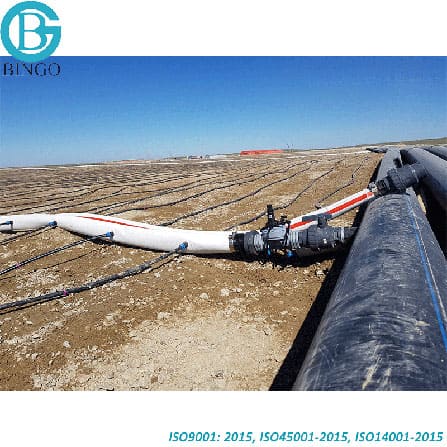Discover the Production Process Behind High-Quality HDPE Pipe and Its Applications
The production procedure of top notch HDPE pipelines is detailed and methodical. It begins with the choice of basic materials that boost efficiency. Following this, ethylene undergoes polymerization to form material, which is then formed via extrusion. Quality control is vital, making sure that the end product satisfies rigorous criteria. The journey of HDPE pipelines does not finish with manufacturing. Their applications throughout different markets reveal a wider relevance worth checking out.
Understanding HDPE: Residences and Advantages

High-density polyethylene (HDPE) is a versatile thermoplastic recognized for its longevity and resistance to various ecological aspects. This product exhibits outstanding tensile stamina, making it suitable for demanding applications. Its low-density structure adds to a light-weight product, helping with simplicity of managing and setup. HDPE also showcases exceptional resistance to chemicals, which minimizes deterioration when revealed to extreme materials.
The product's reduced wetness absorption additionally boosts its longevity, making it perfect for use in pipelines and tank. In addition, HDPE is resistant to ultraviolet (UV) radiation, guaranteeing that products maintain their integrity also when subjected to sunlight. Its flexibility permits for the production of elaborate forms without endangering toughness. The environment-friendly nature of HDPE, frequently stemmed from recycled materials, contributes to its allure, promoting lasting techniques in manufacturing. In general, these buildings and advantages make HDPE a recommended selection for numerous industrial and customer applications.
Resources Option for HDPE Production
The option of resources for HDPE manufacturing is vital to verify the end product meets the desired specifications and quality requirements. High-density polyethylene (HDPE) is mainly created from polymerized ethylene, originated from nonrenewable fuel sources such as gas or petroleum. The quality of these feedstocks greatly affects the mechanical and thermal properties of the last HDPE.
Additives also play a substantial function in enhancing HDPE's performance, including anti-oxidants, UV stabilizers, and colorants, which enhance longevity and resistance to ecological factors. The selection process have to consider not just the chemical make-up of the raw products but also their handling features to guarantee effective manufacturing.
In addition, the sourcing of basic materials ought to focus on sustainability and conformity with ecological policies, as liable techniques are important in today's market. Ultimately, mindful resources option lays the structure for generating high-quality HDPE pipelines ideal for diverse applications.
The Extrusion Process: Shaping HDPE Pipeline
The extrusion process plays an essential role in shaping HDPE pipes, starting with careful material preparation methods that ensure excellent circulation and uniformity. Similarly vital is the layout of the die, which straight influences the final dimensions and surface area quality of the pipeline. Together, these aspects add substantially to the performance and high quality of HDPE pipeline manufacturing.
Material Prep Work Strategies
Reliable manufacturing of HDPE pipes starts with careful material preparation strategies, particularly the extrusion procedure. Throughout this phase, high-density polyethylene material is first dried to remove moisture, making sure ideal circulation characteristics. The resin is after that fed right into the extruder, where it goes through heating and melting, changing right into a thick state. This home heating procedure is thoroughly regulated to keep the material's integrity and efficiency. The molten HDPE is forced with a die, forming it right into a continual pipeline kind. Proper temperature administration during extrusion is essential, as it straight affects the material's homes and the last product top quality. As soon as shaped, the HDPE pipe is cooled and cut to defined sizes, all set for subsequent handling and applications.
Die Layout Relevance
Accuracy in die style plays an essential role in the extrusion procedure of HDPE pipelines. The die acts as the last shaping device, straight influencing the pipeline's measurements, wall surface thickness, and surface coating. A properly designed die guarantees consistent material flow, reducing issues such as abnormalities and weak points. The geometry of the die must be enhanced to fit the certain residential properties of HDPE, including its thickness and thermal habits throughout extrusion. Furthermore, the cooling price of the product as it travels through the die can noticeably impact the more info pipeline's architectural stability. Consequently, spending in sophisticated die modern technology is important for producers aiming to produce premium HDPE pipelines that fulfill industry requirements and consumer assumptions.
High Quality Control Measures in HDPE Manufacturing
Different aspects influence the high quality of HDPE pipe production, reliable top quality control actions are crucial to ensure consistency and dependability in the final item (Texas hdpe pipe manufacturer). Trick quality assurance techniques include strenuous product inspection, validating that the raw polyethylene fulfills recognized criteria for purity and density. Throughout the extrusion process, criteria such as temperature level, stress, and cooling time are carefully monitored to preserve dimensional accuracy and architectural honesty
Furthermore, post-production testing is essential; suppliers usually carry out hydrostatic examinations to evaluate the pipeline's stamina and resistance to stress. Aesthetic evaluations for surface area defects additionally enhance quality control. Accreditation from pertinent requirements companies, like ASTM or ISO, offers an added layer of integrity. By executing these complete high quality control measures, producers can decrease defects, boost performance, and guarantee that the HDPE pipelines meet the certain requirements of numerous applications, inevitably leading to customer complete satisfaction and count on in the item.
Applications of HDPE Pipe Throughout Industries
HDPE pipelines are used throughout various markets as a result of their toughness and flexibility. In water circulation systems, they ensure reliable distribution, while in wastewater management, they provide trustworthy options for waste transport. Additionally, farming irrigation networks gain from HDPE's resistance to corrosion and flexibility, making it a suitable selection for modern-day farming practices.

Water Circulation Solutions
A substantial number of markets count on high-density polyethylene (HDPE) pipes for efficient water circulation systems. Understood for their durability and resistance to rust, HDPE pipelines are commonly made use of in local water supply networks, agricultural irrigation, and commercial applications. Their light-weight nature helps with very easy handling and installation, decreasing labor prices and time. In addition, HDPE pipelines can fit different stress levels, making them ideal for both reduced and high-pressure systems. custom hdpe pipe manufacturing Midland TX. The versatility of the material enables smooth assimilation into existing framework, lessening the need for extensive excavation. HDPE's resistance to chemical seeping assurances that the water provided remains safe and tidy, making it an excellent option for keeping the high quality of potable water across various markets.
Wastewater Management Solutions
Efficient water circulation systems likewise lead the way for innovative wastewater management remedies, where high-density polyethylene (HDPE) pipelines play a considerable duty. Prominent for their durability and resistance to rust, HDPE pipelines are perfect for carrying wastewater in various settings. Their versatility permits easy setup in complex settings, decreasing the need for extensive excavation. Additionally, HDPE's smooth interior surface area reduces friction, enhancing circulation rates and efficiency. These pipelines are likewise resistant to chemical leaching, ensuring that contaminants do not compromise the surrounding setting. Industries, municipalities, and therapy centers significantly count on HDPE pipes for their integrity and longevity, making them a preferred choice for modern wastewater management systems. This flexibility highlights the critical relevance of HDPE pipelines across many applications.
Agricultural Watering Networks
Agricultural watering networks profit substantially from making use of high-density polyethylene (HDPE) pipelines, which provide reliable and trusted water delivery to plants. HDPE pipes are lightweight, making them easy to transfer and mount, while their adaptability enables different configurations in diverse terrains. These pipelines demonstrate outstanding resistance to deterioration, chemicals, and UV radiation, making sure longevity in severe agricultural settings. In addition, their smooth interior surface reduces rubbing loss, optimizing water circulation and reducing energy costs related to pumping. The durability of HDPE pipes, frequently exceeding half a century, adds to decrease upkeep and replacement expenditures. Consequently, farmers progressively depend on HDPE pipelines to enhance irrigation effectiveness and promote sustainable farming techniques, ultimately resulting in enhanced plant yields and source conservation.
Future Fads in HDPE Pipeline Technology
As the demand for lasting and effective infrastructure grows, advancements in HDPE pipeline innovation are positioned to transform different markets. Arising patterns consist of the integration of smart modern technologies, such as sensors and IoT capacities, which assist in real-time tracking of pipeline conditions, reducing upkeep prices and preventing leaks. Furthermore, the advancement of sophisticated manufacturing strategies, such as 3D printing, is making it possible for the production of complex, tailored pipeline styles that accommodate certain task demands.
Moreover, the concentrate on recycling and round economic climate methods is driving the development of HDPE pipelines made from recycled materials, improving sustainability. Enhanced jointing techniques, such as electro-fusion and mechanical installations, are also improving installation effectiveness and dependability. Finally, the expanding focus on environmental regulations is pushing makers to adopt greener manufacturing processes, making sure that HDPE pipelines not just meet sector criteria yet also cultivate an even more sustainable future for framework development.
Regularly Asked Questions
Exactly How Does HDPE Compare to Various Other Plastic Materials?
HDPE outshines several other plastic materials pertaining to resilience, chemical resistance, and flexibility. Its low density and high tensile toughness make it optimal for numerous applications, often surpassing options in both performance and durability.
What Are the Ecological Influences of HDPE Production?
The environmental influences of HDPE manufacturing include greenhouse gas emissions, power usage, and possible contamination from producing procedures. Furthermore, incorrect disposal can result in dirt and water contamination, increasing problems concerning long-lasting ecological results.
Can HDPE Pipeline Be Recycled?
Yes, HDPE pipelines can be recycled. Lots of facilities approve used HDPE for processing, transforming it into brand-new items. This recycling contributes to sustainability initiatives, minimizing plastic waste while saving resources and energy in the production cycle.
What Is the Lifespan of HDPE Pipes?

Just How Do Temperature Level Variations Influence HDPE Pipe Efficiency?
Temperature variants considerably affect HDPE pipeline performance, influencing versatility and strength. High temperature levels can bring about softening, while low temperatures might create brittleness, eventually affecting the pipeline's sturdiness and viability for various applications in diverse environments.